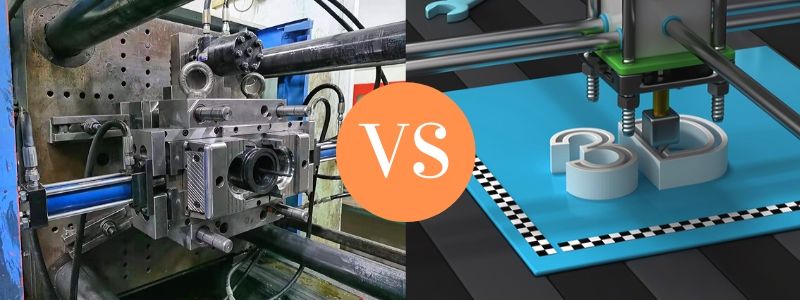
3D printing and injection molding have a lot in common. Both are excellent at making prototypes or replacing parts. Designers realize their designs through these two processes.
In the plastic manufacturing industry, 3D printing and injection molding are usually used for contrast. Talks about 3D printing as the terminator of injection molding abound. It is one of the topics that we are most concerned about who has the highest competitiveness.
So, what is the difference between 3D printing technology and injection molding?
Pros and cons of 3D printing.
3D printing is an important entry point for manufacturing. If you want to print a small number of complex designs, 3D printing is suitable. Here’s what you need to know about 3D printing to help you decide if it’s the right idea for you.
Advantage
1.Low entry cost
You can spend as much money as possible into 3D printing. If this is not a lot, you still have a lot of options. The supply of desktop 3D printers and photosensitive resins will make your injection molding rate lower than injection molding equipment. The continued growth of open source software and hardware in the community provides you with a strong support network.
2.Easy to change
Because of its add-on, you can discover and fix design issues while you are making the model. This makes it possible to avoid wasting the entire material on objects with the same defects. The 3D printer lets you pause the intermediate process and continue in the same place. This requires on-site adjustments, otherwise it will make you start from scratch.
3.Easy to support complex designs
The process of 3D printing adding layers on top of each other. Makes it ideal for creating complex infrastructures. The extruder provides an exquisite feel for the printed details, with previous layers as support.
Disadvantage
1.Slow object output
The detail-oriented process of 3D printing severely limits the ability to print multiple objects at once. Most 3D printers can only produce one or two models at a time.
2.Limited construction volume
Manufacturing with 3D printers is also limited by the size of the print area. Because the extruder arm always has the largest range. In addition, the larger the portion hanging over the edge of the print area, the more unstable the entire design becomes. Can do large-scale 3D printing. But compared to injection molding, this is true even for relatively small 3D printing.
Advantages and disadvantages of injection molding
Injection molding is a tried and tested manufacturing process. It has many things to consider, but not without its own problems to consider.
Advantage
1.Large and simultaneous output
Injection molding is designed to use a large number of molds at one time. The size of these machines can reduce the cost of each mold. With each additional mold, large quantities can be molded. This is perfect if you are ready to mass produce your design.
2.Enhance object strength
Objects made by injection molding consist of a single casting layer. This increases the strength of the product because there are no cracks or weak points. In addition, injection molding can handle a variety of dense materials.
3.Minimal waste
Because injection molding pours material into the mold, it uses as much as needed for each design. This makes it a very effective way to mass produce objects without having to worry about waste.
Disadvantage
1.Limitations of design
Building the mold shrinks the designed geometry in several key ways. First, right angles are not desirable. Because they make it difficult to pull out hardened objects without risk of breakage. The angle of inclination eases the edges with less pressure. Second, injection molding is not suitable for very complex designs.
2.Hard to correct
If an object goes wrong, it means that the mold needs to be completely remade. This will consume a lot of time and money. Experienced manufacturers will inevitably make mistakes.
3.High entry costs
The cost of an injection molding machine alone is as high as six figures. They are designed for industrial use, not for hobby. This does not include the cost of making molds, obtaining materials, and designing and producing.
Manufacturing cost
Due to the wide availability of raw materials for injection molding. Its large-scale and fast standardized production also helps reduce the cost of a single product. Therefore, in terms of manufacturing costs, the cost of injection molding is much lower than 3D printing technology.
However, the real cost saving part of 3D printing is modifying the prototype. Modifying the prototype only requires modifying the CAD model.
In injection molding, if the prototype is a steel mold, the cost of modification will be relatively low. But the cost of aluminum molds will be much higher. This is why many mold companies or individuals choose to create 3D printed molds.
Application area
The injection molding process enables mass-produced articles of uniform shape. Therefore, it is very suitable for mass production of standardized products.
3D printing can print raw materials into physical models, and even directly manufacture parts or molds. This effectively shortens the product development cycle. Has been widely used in maker, architectural design, mold model design and other fields.
